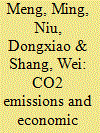|
|
|
Sort Order |
|
|
|
Items / Page
|
|
|
|
|
|
|
| Srl | Item |
| 1 |
ID:
111439


|
|
|
|
|
| Publication |
2012.
|
| Summary/Abstract |
For the period of the 12th Five-Year Plan (2011-2015), the Chinese government has decided to reconsider and adjust its policies on economic development because of the pressures of CO2 emissions and fossil energy consumption. The current paper adopts the logarithmic Stochastic Impacts by Regression on Population, Affluence, and Technology (STIRPAT) model to simulate the relationship between CO2 emissions and other economic development factors in China. Three groups of outliers are found using samples from 1989 to 2008 and the Partial Least Square (PLS) regularity test method. The outlier analysis reveals three important areas for CO2 reduction: (a) decreasing the share of coal to the total energy consumption and replacing it with non-fossil energies; (b) controlling vehicles used in the cities as well as (c) adjusting industrial structure. Furthermore, based on the social and economic realities of China, the current paper designs six feasible development scenarios for the period covered by the 12th Five-Year Plan and predicts the values of each factor in each scenario. The values can test the implementation of China's CO2 control development concept. The experiences obtained by outlier analysis can be of significant reference value for realizing the predicted scenarios.
|
|
|
|
|
|
|
|
|
|
|
|
|
|
|
|
| 2 |
ID:
171485


|
|
|
|
|
| Summary/Abstract |
The “13th Five-Year Plan” for wind power has proposed that it will reach grid parity and compete with power and hydropower. Accordingly, many doubts have been raised. Is the wind power in China already equipped with conditions for grid parity? What is the impact on the development of wind power? To solve these doubts, this study employs a system dynamics model to judge whether China can achieve grid parity for wind power. First, the factor indicator system is constructed from the aspects of wind power production, consumption, and curtailment. Second, the trend of wind power curtailment, cost, revenue, and installed capacity are predicted from 2005 to 2030. Third, three scenarios are set to simulate the impact of grid parity on wind power. Empirical results show that: (1) Net revenue and installed capacity will continue to increase, while the wind power curtailment will gradually reduce. (2) When the subsidy is decreased to 0, revenue will significantly reduce, and the installed capacity will reduce by nearly 1/4. (3) The Chinese government should not abolish all subsidies for wind power to achieve grid parity in 2020. To prompt the process for the grid parity of wind power, some policy implications are proposed.
|
|
|
|
|
|
|
|
|
|
|
|
|
|
|
|
| 3 |
ID:
182721


|
|
|
|
|
| Summary/Abstract |
Using high-speed railway (HSR) construction in China as a quasi-experiment, this paper contributes to the understanding of how transportation infrastructure affects entrepreneurship. On the basis of a difference-in-difference approach, we find that access to an HSR connection leads to an increase in entrepreneurship by approximately 3.5 percentage points (35% of the mean). Mechanism exploration suggests that market potential is the main channel that HSR encourages entrepreneurial activities, which is realized by accelerated information sharing and face-to-face interactions. And the effect is bigger for high-educated families, wealthy families and in large cities.
|
|
|
|
|
|
|
|
|
|
|
|
|
|
|
|
|
|
|
|
|